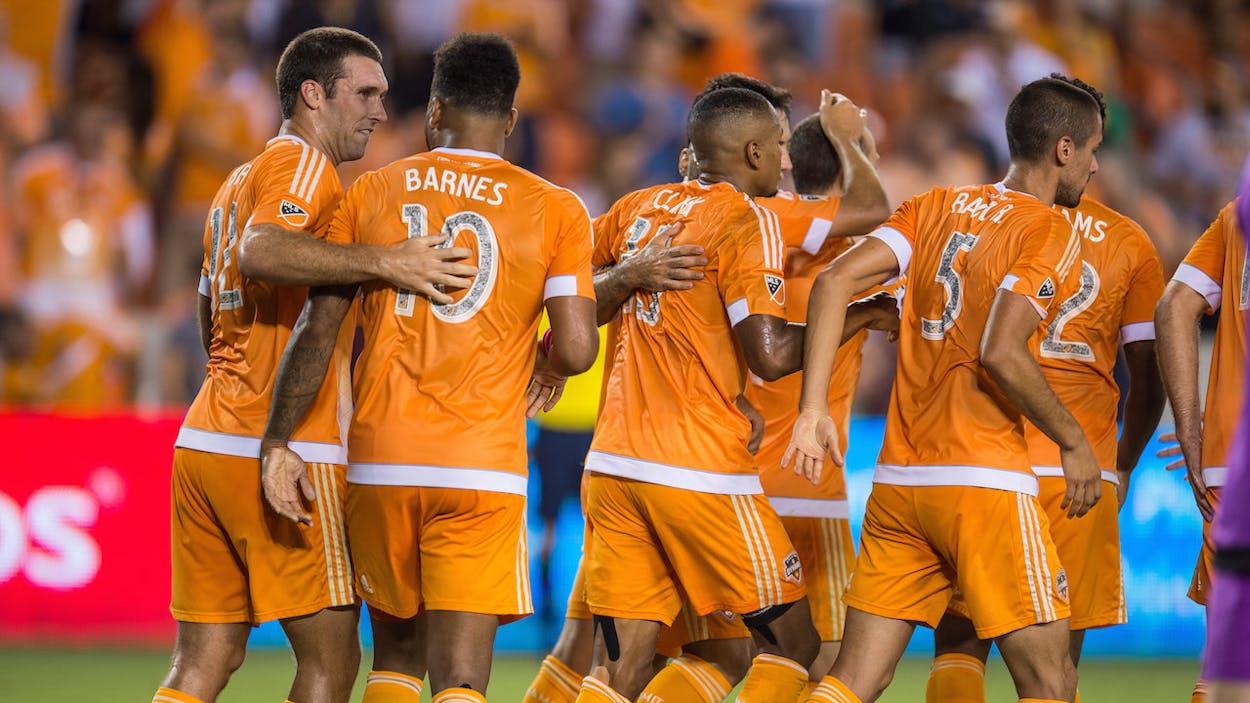Soccer is the future of American sports, and it has been since at least 1975, when Brazilian great Pelé signed to the New York Cosmos in an attempt to usher in a rabid American fan base. Although the game has been just a few years away from permeating the consciousness of U.S. sports for, you know, four decades now, there are people who believe that the time is coming when the national obsession with the kind of football where using your hands is a penalty (not to mention basketball, baseball, and hockey) will fade enough to allow soccer to shine. Yes, even in Texas.
How else do you explain Forbes‘ list of Major League Soccer’s most valuable franchises, which puts the Houston Dynamo at number three with a cool $200 million, and FC Dallas at ninth with $146 million?
Wherever those numbers come from, that doesn’t mean major profitability. While the Dynamo does turn a profit—the club spends $26 million a year, but takes in an extra $5 million—they’re one of only eight organizations in the league in the black. FC Dallas, meanwhile, had a net operating loss of $3,000,000, which puts them in the same company as most other MLS franchises.
It’s not uncommon for sports franchises to post occasional losses—the Detroit Lions famously posted a number of consecutive years with negative profitability after building a new stadium and paying out massive salaries prior to the creation of the NFL’s rookie wage scale—but it’s strange to see franchises in a league as precarious as MLS, many of which have never turned a profit, valued so highly. Back in 2013, for example, California’s Chivas USA club was valued at $64 million. That may be small potatoes for a major American sports franchise, but that’s a lot of money—yet it wasn’t enough to keep the club from going bankrupt the following year.
Costs can go down even while player salaries will remain fixed (or rise, if MLS wants to compete with international soccer for talent), so it’s important to consider revenue in addition to profitability when considering these numbers. But even in that arena, the picture isn’t particularly rosy. Forbes reported that the Dynamo had a revenue of $32.6 million in 2013, and the 2015 number for the team’s revenue is listed at $26 million.
The actual numbers for each team aren’t public, so Forbes is working off of what public information there is for all of these estimates. Still, it’s hard to imagine how the Dynamo’s value has gone up by $75 million dollars in two years, if both the revenue and profitability are down.
The situation up in Frisco, where FC Dallas plays, is a little more promising: the $49 million boost in value is accompanied by a slight rise in revenue, at least, from $24.2 million to $25 million, even though they lost $6 million for the 2015 valuation. But $146 million is an awfully big estimate for an enterprise that loses money and has never been profitable by more than a narrow margin.
Which suggests that the value of both FC Dallas and the Houston Dynamo is determined by projections of future revenue—the same way that an NFL franchise that might have lost money in 2013 would still be valuable in the future once things turn around. Cut costs, raise ticket prices, get a new TV licensing deal, sell jerseys, and split a larger pie that the owners divvy up, and a loss can become a profit pretty quickly. But those projections are curious when talking soccer. Attendance is good, but TV ratings are still abysmal, and without lucrative TV deals, it’s hard to believe that MLS teams are sustainable. The league signed an eight-year TV deal with ESPN, Univision, and Fox last year worth an average of $90 million per year. That sounds like a lot of money—until you consider that the NFL’s TV deals are worth an average of $5 billion a year.
Forbes estimates that the average MLS franchise is valued at $157 million. The average NFL team, meanwhile, is valued by the magazine at $1.43 billion. If the NFL brings in 55 times what MLS brings in on television, where the biggest audiences and most cultural saturation is to be found, how is it that the average value of its franchises is only nine times more than what an average Major League Soccer team is worth?
Ultimately, of course, a professional sports franchise, like anything else in a free market, is worth whatever someone is willing to pay for it. When Chivas USA folded last year, the rights to the team were purchased by Major League Soccer and then sold to a group of investors for a figure near $100 million. Sports franchises are cool, and there are only so many to go around, especially in the U.S. So people with too much money to burn who want to get in on the action may be forced to overpay for soccer franchises if they can’t afford the billions it takes to enter the ranks of NFL, NBA, or MLB owners. Which means that the numbers Forbes slapped on the Dynamo and FC Dallas might not be wrong—they’re just absurd.








